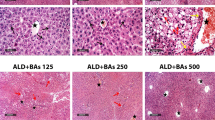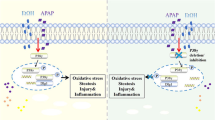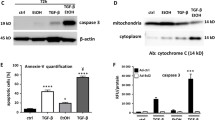Abstract
It is widely accepted that the consumption of alcohol may lead to hepatic injuries such as hepatic fibrosis and cirrhosis. However, consumption of Maotai, one of the famous liquors in China, is found to have no obvious relevance with hepatic injury as ordinary white wine does in both epidemiological and histopathological studies. Present study used human hepatoma cell line Hep3B to address the mechanisms involved in the resistance of alcohol-induced hepatic injury by Maotai liquor. We found that exposure of Hep3B cells to Maotai residue without ethanol (MRWE) resulted in the increased GST A1 anti-oxidant responsive element (ARE) transcriptional expression, while MRWE treatment did not affect Nrf-2-dependent transcriptional activity. Those findings were further confirmed at all time points and doses tested, suggesting that GST A1 transcription was regulated by MRWE via an Nrf-2-independent pathway. Consistent with GST A1 induction, the phosphorylation of c-Jun, extracellular signal-regulated kinases (ERKs) and p38 kinase (p38 K), were also observed in MRWE-treated Hep3B cells. Furthermore, pretreatment of cells with either PD98059 (an inhibitor specific for MEK1/2-ERKs pathway) or SB202190 (an inhibitor specific for p38 K) led to a significant decrease in the induction of GST A1 transcriptional expression by MRWE treatment. Our results indicate that certain content in MRWE is able to induce GST A1 ARE transcriptional expression, which may provide protective effects for hepatic cells by antagonizing the oxidative stress derived from ethanol via an ERKs- and p38 K-dependent pathway.
Similar content being viewed by others
Abbreviations
- ARE:
-
anti-oxidant responsive element
- ERKs:
-
extracellular signal regulated kinases
- FBS:
-
fetal bovine serum
- GST:
-
glutathione S-transferase
- JNKs:
-
c-Jun N-terminal kinases
- MAPKs:
-
mitogen activating protein kinases
- MEM:
-
Eagle's Minimal Essential Medium
- NFκB:
-
nuclear factor kappa B
- MRWE:
-
Maotai residue without ethanol
- Nrf-2:
-
nuclear factor E2 p45-related factor 2
- p38 K:
-
p38 MAP kinase
References
Wu J, Cheng ML, Zhang GH, Zhai RW, Huang NH, Li CX, Luo TY, Lu S, Yu ZQ, Yao YM, Zhang YY, Ren LZ, Ye L, Li L, Zhang HN: Epidemiological and histopathological study of relevance of Guizhou Maotai liquor and liver diseases. World J Gastroenterol 8: 571–574, 2002
Miyano S, Maeyama S, Iwaba A, Ogata S, Koike J, Kishi M, Uchikoshi T: A clinicopathological study of acute hepatitis in heavy drinkers, unrelated to hepatitis A, B, or C viruses. Alcohol Clin Exp Res 25: 69S–76S, 2001
Bellentani S, Saccoccio G, Costa G, Tiribelli C, Manenti F, Sodde M, Croce LS, Sasso F, Pozzato G: Cristianini G and Brandi and the Dionysos Study Group G: Drinking habits as cofactors of risk for alcohol induced liver damage. Gut 41: 845–850, 1997
Tomáš Z, Lenka F, Oto M, Marta J, Jiina C, Ivan M, Stanislav t, Ludmila M, Petr P: Oxidative stress, metabolism of ethanol and alcohol-related diseases. J Biomed Sci 8: 59–70, 2001
Cheng M, Wu L, Zhang W, Wang H, Li C, Huang N, Yao Y, Ren L, Ye L, Li L: Effect of Maotai liquor on the liver: an experimental study. Hepatobiliary Pancreat Dis Int 3: 93–98, 2004
Cheng ML, Wu J, Wang HQ, Xue LM, Tan YZ, Ping L, Li CX, Huang NH, Yao YM, Ren LZ, Ye L, Li L, Jia ML: Effect of Maotai liquor in inducing metallothioneins and on hepatic stellate cells. World J Gastroenterol 8: 520–523, 2002
Koch OR, Pani G, Borrello S, Colavitti R, Cravero A, Farre S, Galeotti T: Oxidative stress and antioxidant defenses in ethanol-induced cell injury. Mol Aspects Med 25: 191–198, 2004
Henderson C, McLaren A, Moffat G, Bacon E, Wolf C: Pi-class glutathione S-transferase: regulation and function. Chem Biol Interact 111–112: 69–82, 1998
Cookson MS, Reuter VE, Linkov I, Fair WR: Glutathione S-transferase PI (GST-pi) class expression by immunohistochemistry in benign and malignant prostate tissue. J Urol 157: 673–676, 1997
Mannervik B, Danielson U: Glutathione transferases—structure and catalytic activity. Crit Rev Biochem Mol Biol 23: 283–337, 1988
Coles B, Ketterer B: The role of glutathione and glutathione transferases in chemical carcinogenesis. Crit Rev Biochem Mol Biol 25: 47–70, 1990
Strange RC, Spiteri MA, Ramachandran S, Fryer AA: Glutathione-S-transferase family of enzymes. Mutat Res 482: 21–26, 2001
Mannervik B, Angstrom Lin P, Guthenberg C, Jensson H, Tahir MK, Warholm M, Jornvall H: Identification of three classes of cytosolic glutathione transferase common to several mammalian species: correlation between structural data and enzymatic properties. PNAS 82: 7202–7206, 1985
Meyer DJ, Coles B, Pemble SE, Gilmore KS, Fraser GM, Ketterer B: Theta, a new class of glutathione transferases purified from rat and man. Biochem J 274: 409–414, 1991
Ji X, Rosenvinge E, Johnson W, Tomarev S, Piatigorsky J, Armstrong R, Gillil G: Three-dimensional structure, catalytic properties, and evolution of a sigma class glutathione transferase from squid, a progenitor of the lens S-crystallins of cephalopods. Biochemistry. 34: 5317–5328, 1995
Jonathan DR, Edward N, Irving L: Subunit diversity and tissue distribution of human glutathione S-transferases: interpretations based on electrospray ionization-MS and peptide sequence-specific antisera. Biochem J 325: 481–486, 1997
Yang Y, Yang Y, Trent MB, He N, Lick SD, Zimniak P, Awasthi YC, Boor PJ: Glutathione-S-transferase A4–4 modulates oxidative stress in endothelium: possible role in human atherosclerosis. Atherosclerosis 173: 211–221, 2004
Itoh K, Chiba T, Takahashi S, Ishii T, Igarashi K, Katoh Y, Oyake T, Hayashi N, Satoh K and Hatayama I: An Nrf2/small Maf heterodimer mediates the induction of Phase II detoxifying enzyme genes through antioxidant response elements. Biochem Biophys Res Commun 236: 313–322, 1997
Chan K, Kan YW: Nrf2 is essential for protection against acute pulmonary injury in mice. PNAS 96: 12731–12736, 1999
Cho HY, Reddy SPM, Yamamoto M, Kleeberger SR: The transcription factor NRF2 protects against pulmonary fibrosis. FASEB J: 1258–1260, 2004
Shaulian E, Karin M: AP-1 as a regulator of cell life and death. Nat Cell Biol 4: E131–E136, 2002
Friling RS, Bergelson S, Daniel V: Two adjacent AP-1-like binding sites form the electrophile-responsive element of the murine glutathione S-transferase Ya subunit gene. PNAS 89: 668–672, 1992
Pinkus R, Weiner LM, Daniel V: Role of oxidants and antioxidants in the Induction of AP-1, NF-κ B, and glutathione S-transferase gene expression. J Biol Chem 271: 13422–13429, 1996
Vollgraf U, Wegner M, Richter-Landsberg C: Activation of AP-1 and Nuclear Factor- B transcription factors is involved in hydrogen peroxide-induced apoptotic cell death of olligodendrocytes. J Neurochem 73: 2501–2509, 1999
Kwak MK, Kensler TW, Casero JRA: Induction of phase 2 enzymes by serum oxidized polyamines through activation of Nrf2: effect of the polyamine metabolite acrolein. Biochem Biophys Res Commun 305: 662–670, 2003
Kwak MK, Itoh K, Yamamoto M and Kensler TW: Enhanced expression of the transcription factor Nrf2 by cancer chemopreventive agents: role of antioxidant response element-like sequences in the nrf2 promoter. Mol Cell Biol 22: 2883–2892, 2002
Wang J, Ouyang W, Li J, Wei L, Ma Q, Zhang Z, Tong Q, He J Huang C: Loss of tumor suppressor p53 decreases PTEN expression and enhances signaling pathways leading to activation of activator protein 1 and nuclear factor κB induced by UV radiation. Cancer Res 65: 6601–6611, 2005
Chen J, Yan Y, Li J, Ma Q, Stoner GD, Ye J, Huang C: Differential requirement of signal pathways for benzo[a]pyrene (B[a]P)-induced nitric oxide synthase (iNOS) in rat esophageal epithelial cells. Carcinogenesis 26: 1035–1043, 2005
Huang C, Li J, Costa M, Zhang Z, Leonard SS, Castranova V, Vallyathan V, Ju G, Shi X: Hydrogen peroxide mediates activation of nuclear factor of activated T cells (NFAT) by nickel subsulfide. Cancer Res 61: 8051–8057, 2001
Bergelson S and Daniel V: Cooperative interaction between Ets and AP-1 transcription factors regulates induction of glutathione S-transferase Ya gene expression. Biochem Biophys Res Commun 200: 290–297, 1994
Morceau F, Duvoix A, Delhalle S, Schnekenburger M, Dicato M, Diederich M: Regulation of glutathione S-transferase P1–1 gene expression by NF-κB in tumor necrosis factor alpha-treated K562 leukemia cells. Biochem Pharmacol 67: 1227–1238, 2004
Duvoix A, Schnekenburger M, Delhalle S, Blasius R, Borde-Chiche P, Morceau F, Dicato M, Diederich M: Expression of glutathione S-transferase P1–1 in leukemic cells is regulated by inducible AP-1 binding. Cancer Lett 216: 207–219, 2004
Wheeler MD, Thurman RG: Up-regulation of CD14 in liver caused by acute ethanol involves oxidant-dependent AP-1 pathway. J Biol Chem 278: 8435–8441, 2003
Juan Román, Anna Colell, Carmen Blasco, Joan Caballeria, Albert Parés, Joan Rodés, Fernández-Checa JC: Differential role of ethanol and acetaldehyde in the induction of oxidative stress in HEP G2 cells: Effect on transcription factors AP-1 and NF-κB. Hepatol 30: 1473–1480, 1999
Piechaczyk M, Blanchard J: c-fos proto-oncogene regulation and function. Crit Rev Oncol Hematol 17: 93–131, 1994
Angel P, Karin M: The role of Jun, Fos and the AP-1 complex in cell-proliferation and transformation. Biochim Biophys Acta 1072: 129–157, 1991
Karin M: The regulation of AP-1 activity by mitogen-activated protein kinases. J Biol Chem 270: 16483–16486, 1995
Vinciguerra M, Vivacqua A, Fasanella G, Gallo A, Cuozzo C, Morano A, Maggiolini M, Musti AM: Differential phosphorylation of c-Jun and JunD in response to the epidermal growth factor is determined by the structure of MAPK targeting sequences. J. Biol. Chem. 279: 9634–9641, 2004
Sies H: Oxidative stress: from basic research to clinical application. Am J Med 91: 31S–38S, 1991
Nagy LE: Molecular aspects of alcohol metabolism: transcription factors involved in early ethanol-induced liver injury. Annu Rev Nut 24: 55–78, 2004
Ainbinder E, Bergelson S, Pinkus R, Daniel V: Regulatory mechanisms involved in activator-protein-1 (AP-1)-mediated activation of glutathione-S-transferase gene expression by chemical agents. Eur J Biochem 243: 49–57, 1997
Muller JM, Rupec RA, Baeuerle PA: Study of gene regulation by NF-[κ]B and AP-1 in response to reactive oxygen intermediates. Methods 11: 301–312, 1997
Hiromi I, Mohamed SS, Ikuko K, Ichiro H, Kimihiko S, Shigeki T, Masami M, Shinzo N, Masaharu S: Activation of mouse Pi-class glutathione S-transferase gene by Nrf2 (NF-E2-related factor 2) and androgen. Biochem J 364: 563–570, 2002
Jowsey IR, Jiang Q, Itoh K, Yamamoto M, Hayes JD: Expression of the aflatoxin B1–8,9-epoxide-metabolizing murine glutathione S-transferase A3 subunit is regulated by the Nrf2 transcription factor through an antioxidant response element. Mol Pharmacol 64: 1018–1028, 2003
Shukla GS, Shukla A, Potts RJ, Osier M, Hart BA, Chiu JF: Cadmium-mediated oxidative stress in alveolar epithelial cells induces the expression ofgamma-glutamylcysteine synthetase catalytic subunit and glutathione S-transferase alpha and pi isoforms: Potential role of activator protein-1. Cell Biol Toxicol 16: 347–362, 2000
Sun Y, Oberley LW: Redox regulation of transcriptional activators. Free Radic Biol Med 21: 335–348, 1996
Whitmarsh AJ, Davis RJ: Transcription factor AP-1 regulation by mitogen-activated protein kinase signal transduction pathways. J Mol Med 74: 589–607, 1996
Monje P, Marinissen MJ, Gutkind JS: Phosphorylation of the carboxyl-terminal transactivation domain of c-Fos by extracellular signal-regulated kinase mediates the transcriptional activation of AP-1 and cellular transformation induced by platelet-derived growth factor. Mol Cell Biol 23: 7030–7043, 2003
Chen W, Bowden GT: Role of p38 mitogen-activated protein kinases in ultraviolet-B irradiation-induced activator protein 1 activation in human keratinocytes. Molecular Carcinogenesis 28: 196–202, 2000
Author information
Authors and Affiliations
Corresponding author
Rights and permissions
About this article
Cite this article
Zhang, D., Lu, H., Li, J. et al. Essential roles of ERKs and p38K in up-regulation of GST A1 expression by Maotai content in human hepatoma cell line Hep3B. Mol Cell Biochem 293, 161–171 (2006). https://doi.org/10.1007/s11010-006-9238-z
Received:
Accepted:
Published:
Issue Date:
DOI: https://doi.org/10.1007/s11010-006-9238-z




